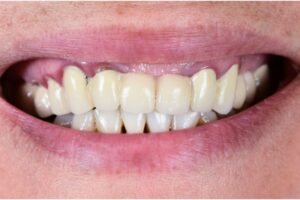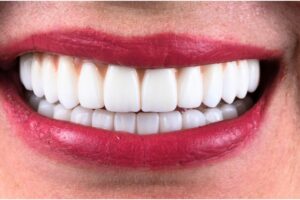Veneers have become one of the most famous cosmetic dental solutions. They enhance your smile by addressing imperfections like discoloration, chips, gaps, and misaligned teeth.
However, when choosing the correct veneer form, the decision often boils down to two essential options: composite and porcelain.
Each material has advantages and drawbacks, making selection a crucial factor in achieving the preferred final results. In this guide, we will offer a detailed comparison of composite and porcelain veneers, exploring their variations in phrases of value, sturdiness, aesthetic enchantment, and more.
Call me For any information (210) 533-8191
“We value your feedback! If you’ve visited us, please take a moment to leave a review on our Google My Business page: Leave a Review. Your input helps us improve and serve you better!”
What Are Veneers?
Veneers are thin shells and custom-made covers that are applied to the surface of your teeth to restore their appearance and natural look. These veneers are crafted to match the patient’s natural teeth’ color, shape, and size, resulting in a seamless and beautiful smile.

It is used for various problems, including discoloration, chips, cracks, gaps, and misalignment, providing patients with a long-lasting solution to achieve their desired smile. It enhances your aesthetic and boasts durability and resistance, making it a trendy choice.
Composite Veneers
Composite veneers are a type of cosmetic dental veneer made from a tooth-colored resin material that is applied directly to the teeth. They improve the appearance of teeth by correcting issues such as discoloration, minor chips, gaps, or slight misalignment. Composite veneers are typically applied in a single dental visit and are more affordable than porcelain veneers.
Application Process
The dentist applies composite resin directly to the tooth’s front surface, shaping and molding it to achieve the desired look. The resin is applied in layers, and each layer is hardened (or “cured”) with a special light. The dentist can build the veneer to the correct thickness and shape.
Once the veneer is formed, the dentist will polish the surface to give it a smooth, natural shine that mimics the appearance of natural teeth.
Advantages of Composite Veneers
Composite veneers are typically less expensive than porcelain veneers, making them a more budget-friendly option. Unlike porcelain veneers requiring multiple appointments, the procedure is often completed in a single visit.

Less tooth enamel is often removed than porcelain veneers, preserving a more natural tooth structure. Because minimal enamel removal is required, composite veneers are usually considered reversible.
What are the disadvantages of composite veneers?
Composite resin is less solid and long-lasting than porcelain, making it more prone to chipping and wear. Composite veneers are also more susceptible to staining from foods, drinks, and smoking, so they may require more frequent touch-ups or replacement. With proper care, composite veneers typically last 5–7 years, compared to porcelain veneers, which can last 10–15 years or more.
Porcelain Veneers
Porcelain veneers are thin, custom-made shells of high-quality ceramic material bonded to the teeth’ front surface to enhance their appearance. They are popular in cosmetic dentistry due to their durability, natural appearance, and long-lasting results. Porcelain veneers often correct dental imperfections, such as discoloration, chipped teeth, gaps, or misaligned teeth, providing a highly aesthetic and permanent smile solution.
Application Process
The dentist first examines your teeth and discusses your aesthetic goals. An impression or digital scan of your teeth is taken and sent to a dental laboratory, where the porcelain veneers are custom-made to fit your teeth precisely and match your natural tooth color.
In some cases, temporary veneers may be applied while the permanent ones are being made. Once the custom veneers are ready, they are bonded to the teeth with a strong dental adhesive.
The dentist ensures the fit and appearance are perfect before curing the adhesive with a special light to secure the veneers.
Advantages of Porcelain Veneers
Porcelain veneers mimic the translucency and shine of natural tooth enamel, offering a highly aesthetic, lifelike result. Porcelain is a strong and durable material resistant to chipping and wear. Porcelain veneers can last 10–15 years or more with proper care.
They are also highly resistant to staining from coffee, tea, wine, and other foods, making them easier to maintain compared to composite veneers.
Disadvantages of Porcelain Veneers
Porcelain veneers are more expensive than composite veneers due to the quality of materials and the detailed fabrication process. The procedure requires removing a small amount of enamel from the tooth surface, which makes it irreversible.
Getting porcelain veneers typically requires two or more dental appointments—one for tooth preparation and impressions and another for placement. If a porcelain veneer chips or cracks, it cannot be easily repaired and may need to be fully replaced.
Key Differences Between Composite and Porcelain Veneers
Material Composition
Composite Veneers: Made from composite resin, a tooth-colored material directly applied and sculpted on the tooth surface.
Porcelain Veneers: Made from a durable ceramic material that is custom-crafted in a dental lab and then bonded to the tooth.
Cost
Composite Veneers are generally more affordable, ranging from $250 to $1,500 per tooth, depending on the complexity and location.
Porcelain Veneers are more expensive, typically costing between $1,000 and $2,500 per tooth, due to the lab work, custom fabrication, and higher-quality materials.
Durability and Longevity
Composite Veneers are less durable and have a lifespan of about 5–7 years. They are more prone to chipping, cracking, and wear and require more frequent repairs or replacements.
Porcelain Veneers are more durable, lasting 10–15 years or longer with proper care. They are resistant to chipping and wear, making them a better long-term investment.
Aesthetic Appearance
Composite Veneers: While composite veneers can achieve an excellent cosmetic result, they tend to be less translucent and shiny than porcelain.
Porcelain veneers: Known for their superior aesthetics, porcelain veneers closely mimic real teeth’ natural translucency and reflectivity, providing a more lifelike and natural appearance.
More Article:
7 Tips For Taking Care of Your Veneers in San Antonio, TX
What is Full Mouth Reconstruction in San Antonio TX
Dental Bonding or Veneers: How to Make the Right Choice
From Application to Admiration: How Long Do Porcelain Veneers Last?
Which is better porcelain or composite veneers?
Composite Veneers are best for individuals seeking a quick, cost-effective solution for minor cosmetic issues, such as small chips, gaps, or discoloration. They are ideal for those who want reversible treatment with easy repairs.
Porcelain Veneers are better suited for individuals looking for a long-term, durable, and highly aesthetic solution, especially for more severe cosmetic concerns. They are great for those willing to invest in a higher-quality, lasting result.
By considering these differences, you can make an informed decision about which type of veneer best suits your needs and preferences.

